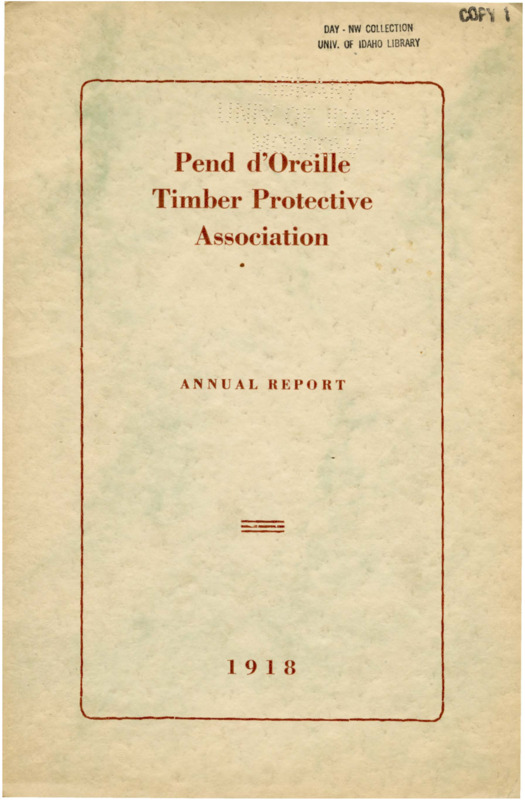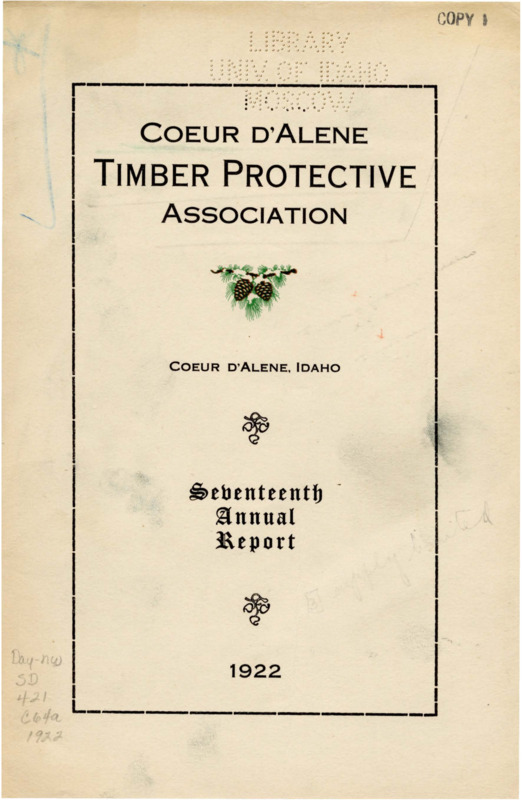![Forest Fire, 1910 - Wallace [1910]](https://cdil.lib.uidaho.edu/fire-lines/objects/im-10.jpg)
This essay was largely born of an attempt to research the history of fire in the Northwest, using the University of Idaho’s library archives as a starting place.
In the archives, one can find the beautiful photos and remarkable accounts of the 1910 fire. One can also find the pamphlets for Idaho’s Timber Protective Associations—which seem to me to be the embodiment of a specific brand of amnesiac, forever-present, subject-object thinking.
In a series of yearly reports, preserved in the University of Idaho’s Special Collections, the Associations’ Fire Wardens call for increasingly more funds, tools, and supplies in order to suppress, “in its infancy,” every single fire.
And yet, like most historical artifacts, the pamphlets might also help us to avoid a similarly myopic perspective on our own time.
In the 1918 annual report from the Pend d’Oreille Timber Protective Association, the Fire Warden says the drought is terrible, the worst he’s seen since 1910. They are terrified, all summer, by the prospect of a fire starting, because most of the able men are mobilized in France, in the trenches of the First World War. Others, of course, will soon be dying in the 1918 epidemic of influenza.

Pend d’Oreille Timber Protective Association Annual Report
This 1918 report in particular throws 2020 into a different perspective.
In the 1922 report published by the Priest Lake Timber Protective Association, the Fire Warden says the smoke was laying so thick upon the land that, by early July, the fire lookouts were totally useless. Just a sea of white. Not a drop of rain.

Coeur d’Alene Timber Protective Association Seventeenth Annual Report
Of course, this is decidedly not to suggest that climate change isn’t real, or that droughts and heat waves in the West are not growing more intense and more common. All of that, too, is a part of the Pyrocene. But if there’s anything that can be learned from the early firefighters of the Northwest, it is this: suppression never works. Not of fires. Not of stories. Not of memories. Not of fear. And most definitely not of history—not of complicating, temporally expansive context.
One thing is notably missing from the University of Idaho’s archives. Though the university sits on the homelands of the Nimiipuu (Nez Perce), Palus (Palouse) and Schitsu’umsh (Coeur d’Alene) tribes, it lacks any historical artifacts or accounts that relate to the relationships between these tribes and fire.
On the one hand, this makes sense. There’s a deeply understandable lack of trust, and desire not to give Indigenous knowledge and artifacts to colonial institutions that will, at best, ignore or misuse them.
But it feels important to acknowledge their absence. Today, Indigenous perspectives on fire are more valued by the colonial society than they ever have been before—a value arguably born of necessity and terror. Yet these perspectives still raise many complicating questions.
One of these questions is whether or not we have a right to expect that our homes won’t burn. As Drader explains, “A central concept in traditional Nez Perce fire knowledge is that fire cannot be ‘owned’ (interviewee) or controlled: ‘if the fire is naturally started, like through lightning…[residents] can’t live in a dangerous area and expect…the Forest Service to come and put the fire out just because you have your house there’ (interviewee). Thus, in the Nez Perce view, people who live in fire prone areas accept a certain level of risk.”
This complicates our ability to view those people whose houses are lost to fire as victims of something that should not be happening, and it highlights the places where fire intersects with other social and economic problems. When wealthy communities are impacted by fire, the insurance payouts are generous, and the houses are rebuilt—often larger, more expensive, and more luxurious versions. In many low-income Northwestern communities impacted by fire, however, this is not the case. People lose everything, and are left without a safety net to fall back on, amid a landscape where the rising costs of housing amplify the unequal effects of climate change. In many ways, this inequality lies at the heart of the problem. During periods of heavy fire and smoke, those who work outside and those who are unhoused suffer by far the most.
In this context, it remains important to remember that we are living in fire’s home, not the other way around. If the arrival of fire surprised us, it’s not because it was unexpected; it’s because we were immersed in an amnesiac culture all along.